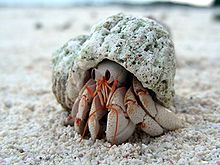Coenobita perlatus
| Coenobita perlatus | |
|---|---|
 |
|
| Scientific classification | |
| Kingdom: | Animalia |
| Phylum: | Arthropoda |
| Subphylum: | Crustacea |
| Class: | Malacostraca |
| Order: | Decapoda |
| Family: | Coenobitidae |
| Genus: | Coenobita |
| Species: | C. perlatus |
| Binomial name | |
|
Coenobita perlatus H. Milne-Edwards, 1837 |
|
| External identifiers for Coenobita perlatus | |
|---|---|
| Encyclopedia of Life | 2922407 |
| WoRMS | 208660 |
| Also found in: ADW | |
Coenobita perlatus, is a species of terrestrial hermit crab. It is known as the strawberry hermit crab because of its reddish orange colours. It is a widespread scavenger across the Indo-Pacific, and is also traded to hobby aquarists.
Adults may grow to an average length of 80 mm (3.1 in) and a mass of 80 g (2.8 oz), and inhabit discarded gastropod shells. They are coloured red or orange; this has led to the species' common name of strawberry hermit crab.C. perlatus and the other members of Coenobita should not be considered easy pets, as the conditions they need in the wild are difficult and expensive to set up in capitivity.
C. perlatus lives in a wide swathe of the Indo-Pacific, from Mauritius, Seychelles and Aldabra in the west to Samoa in the east. In Australia, the species is limited to Christmas Island, the Cocos Islands, the Great Barrier Reef and the Coral Sea Islands Territory. In the wild, animals may live for 25–30 years, but only live for 1–4 years in captivity.
C. perlatus keeps a supply of water in the shell it inhabits. It returns to the sea at night to refresh its water, and it performs osmoregulation by taking appropriate quantities of sea water and fresh water. In the heat of the day, it can bury itself in damp sand as a means of thermoregulation and to prevent water loss. It can also withdraw into its shell and close the aperture with its claws.
...
Wikipedia
